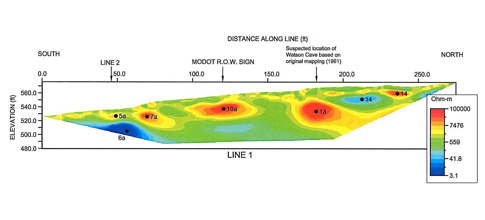
Geotechnology’s Doug Lambert and Boston Fodor Author Paper, Present Findings To Geophysical Organization
St. Louis, MO (November 1, 2012) – Geotechnology, Inc. announced today that a paper authored by Doug Lambert, R.G., and Boston Fodor has been published in the professional journal Carbonates and Evaporites. The journal provides a forum for the exchanges of ideas on all aspects of carbonate and evaporite geology.
The paper is entitled “Use of Electrical Resistivity Surveying To Evaluate Collapse Potential Related to Road Construction Over a Cave”. From the article’s abstract:
Geophysical surveying using the electrical resistivity method was used to help determine the potential for collapse that could occur resulting from the construction of a road over a known cave in the City of Kirkwood (City), Missouri. The City is installing a new water main, which will require construction of an access road through Koestering Park. Underlying the park is historic Watson Cave, which was mapped in 1961. The width and height of the cave varies and appears to be influenced by the presence of vertical fractures that have been widened by solutioning. The depth to the top of the cave is unknown. Exploration by non-intrusive electrical resistivity surveying was performed rather than drilling or test pit exploration because the City desired to limit damage to the cave and densely wooded areas within the park.
A summary of the conclusions:
It was concluded that the limited traffic loads caused by low speed construction-type vehicles would not significantly increase the potential for cave collapse at Watson Cave due to the approximately 30-foot depth of the feature. However, the interpreted shallower features have a comparatively higher potential for collapse. Recommendations included using a Bailey bridge to span large features and using a geogrid-reinforced crushed rock mat to distribute/dissipate heavy wheel loads over narrower features.
In addition to the paper being published, Mr. Lambert was asked to present the findings at the recent Symposium on the Application of Geophysics to Engineering & Environmental Problems (SAGEEP), which took place during the annual meeting of the Environmental & Engineering Geophysical Society.
Doug Lambert, R.G. joined Geotechnology, Inc. in 1987, and at that time was the company’s first geophysicist. Today, Mr. Lambert is the Geophysics Section Manager, managing a staff of geophysicists, investigating technologies and expanding the department’s capabilities with additional staff in the Overland Park, KS and Memphis, TN. He holds a M.S. in geological science (1987) from University of California-Riverside and a B.S. in geophysics (1982) from the Bowling Green State University. He is a registered geologist in Missouri and Illinois.
Boston Fodor has been with Geotechnology since 2007, and is currently a staff geophysicist in the firm’s St. Louis branch. Although assigned to St. Louis, Mr. Fodor takes a significant role in supporting geophysical surveys in Geotechnology’s Overland Park, KS, Memphis, TN and Collinsville, IL branches. Mr. Fodor earned his BS in Geophysics from Saint Louis University in 2007, and is currently a member of the Engineers Club of St. Louis and Association of Environmental & Engineering Geologists (AEG).
